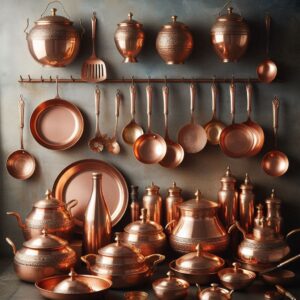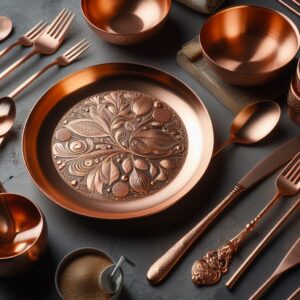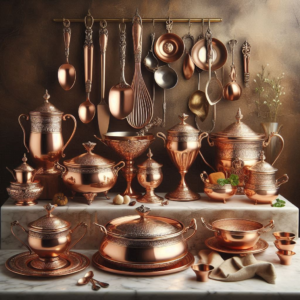Does copper bottle keeps water hot have seen a surge in popularity, often praised for their traditional aesthetic and purported health benefits. These bottles are believed to offer more than just a means of hydration; they are thought to improve wellness by infusing water with copper’s essential minerals.
However, when it comes to thermal insulation, the question arises: Do copper water bottles really keep water hot? The answer is nuanced. Copper is an excellent conductor of heat, which means it can quickly transfer the temperature of the hot water to the outside environment. This property makes copper less effective at maintaining the temperature of the water inside, compared to materials like stainless steel, which are used in thermoses specifically designed to keep liquids hot for extended periods.
In essence, while copper bottles may initially keep water hot, they are not designed for long-term temperature retention. For those looking to keep their beverages hot for longer durations, insulated stainless steel bottles might be a more suitable option.
The Thermal Conductivity of Copper
Thermal conductivity is a measure of a material’s ability to conduct heat. It quantifies the amount of heat that can be transferred through a material due to a temperature gradient. In the International System of Units (SI), thermal conductivity is measured in watts per meter-kelvin (W/m·K).
Copper is known for its high thermal conductivity, which is one of the highest among metals. At 20°C, copper’s thermal conductivity is approximately 401 W/m·K, making it an excellent conductor of heat. This property is due to the free electrons in copper’s atomic structure, which can move more easily and transfer heat between atoms.
When compared to other materials, copper’s thermal conductivity is surpassed only by silver among pure metals. For instance, aluminum has a thermal conductivity of about 237 W/m·K at room temperature, which is significantly lower than copper’s. Stainless steel, often used in thermoses, has a much lower thermal conductivity, typically around 16 W/m·K, which explains why it’s better for insulation purposes.
Copper Insulation Techniques
Copper bottles are typically constructed using a single layer of copper, which is not inherently insulating due to copper’s high thermal conductivity. However, some modern copper bottles may incorporate additional insulation techniques to improve their ability to maintain temperature.
These techniques can include:
- Double-Wall Construction: Some copper bottles may use a double-wall design, where two layers of copper are separated by an air gap or vacuum. This design reduces heat transfer by conduction.
- Vacuum Insulation: Similar to a thermos, a vacuum layer between two walls of copper can significantly reduce heat transfer by conduction and convection.
- Copper Shield: A copper shield or lining can be added to bottles made from other materials, like stainless steel, to enhance thermal conductivity while the outer layer provides insulation.
The role of insulation in maintaining temperature is to reduce the rate of heat transfer between the bottle’s contents and the external environment. Insulation works by minimizing the three modes of heat transfer: conduction, convection, and radiation. Effective insulation materials have a low thermal conductivity, creating a barrier that slows down the flow of heat, thus helping to keep hot contents hot and cold contents cold for longer periods.
Benefits of Copper Bottles for Hot Beverages
Does copper bottle keeps water hot are renowned for their beauty and traditional significance, and they offer several advantages when used for hot beverages:
- Antimicrobial Properties: Copper naturally eliminates many pathogenic microbes, making the water safer to drink.
- Taste Improvement: Some users report that water stored in copper tastes better and feels fresher.
- Ayurvedic Benefits: According to Ayurveda, drinking water stored in copper can balance the three doshas in the body (vata, kapha, and pitta), leading to improved health.

Drinking warm water from copper bottles may also have specific health benefits:
- Digestive Aid: Copper ions can stimulate the production of digestive enzymes, potentially improving digestion and reducing issues like indigestion and acidity.
- Immune Boost: Copper has immune-boosting properties, which may strengthen overall health.
- Anti-Inflammatory: It may help reduce inflammation and pain, particularly beneficial for those with arthritis and similar conditions.
However, it’s important to note that while these benefits are part of traditional beliefs and some user experiences, scientific evidence supporting the health claims of drinking warm water from copper bottles is limited. The actual health impact may vary from person to person, and it’s essential to use copper bottles safely to avoid the risks of copper excess. Would you like to know more about the safe usage of copper bottles or any other related information?
User Experiences and Reviews
While there are numerous user reviews available online, here’s a summary of the general sentiment regarding the effectiveness of copper bottles in keeping water hot:
- User Experiences: Many users appreciate the aesthetic appeal of copper bottles and their antimicrobial properties. However, when it comes to keeping water hot, the reviews are mixed. Some users report that the water remains warm for a short period, while others find that the heat dissipates relatively quickly due to copper’s high thermal conductivity.
- Reviews: On platforms like Amazon, customers often mention that while copper bottles are good for room temperature or cool water, they are not the best choice for maintaining the temperature of hot beverages for extended periods. Users suggest that for long-lasting heat retention, insulated stainless steel bottles might be more effective.
Conclusion
Copper bottles are not the best option for retaining heat due to copper’s high thermal conductivity. They are more suited for storing water at room temperature or for short-term warmth. For those looking to use copper bottles for hot beverages, it’s recommended to preheat the bottle with hot water before use to extend the warmth duration slightly. However, for long-term heat retention, insulated stainless steel bottles are a better choice. Copper bottles are excellent for their antimicrobial properties and traditional aesthetic appeal, but for thermal insulation, other materials outperform them. Buy Best copper water bottles from The Amrit life.











